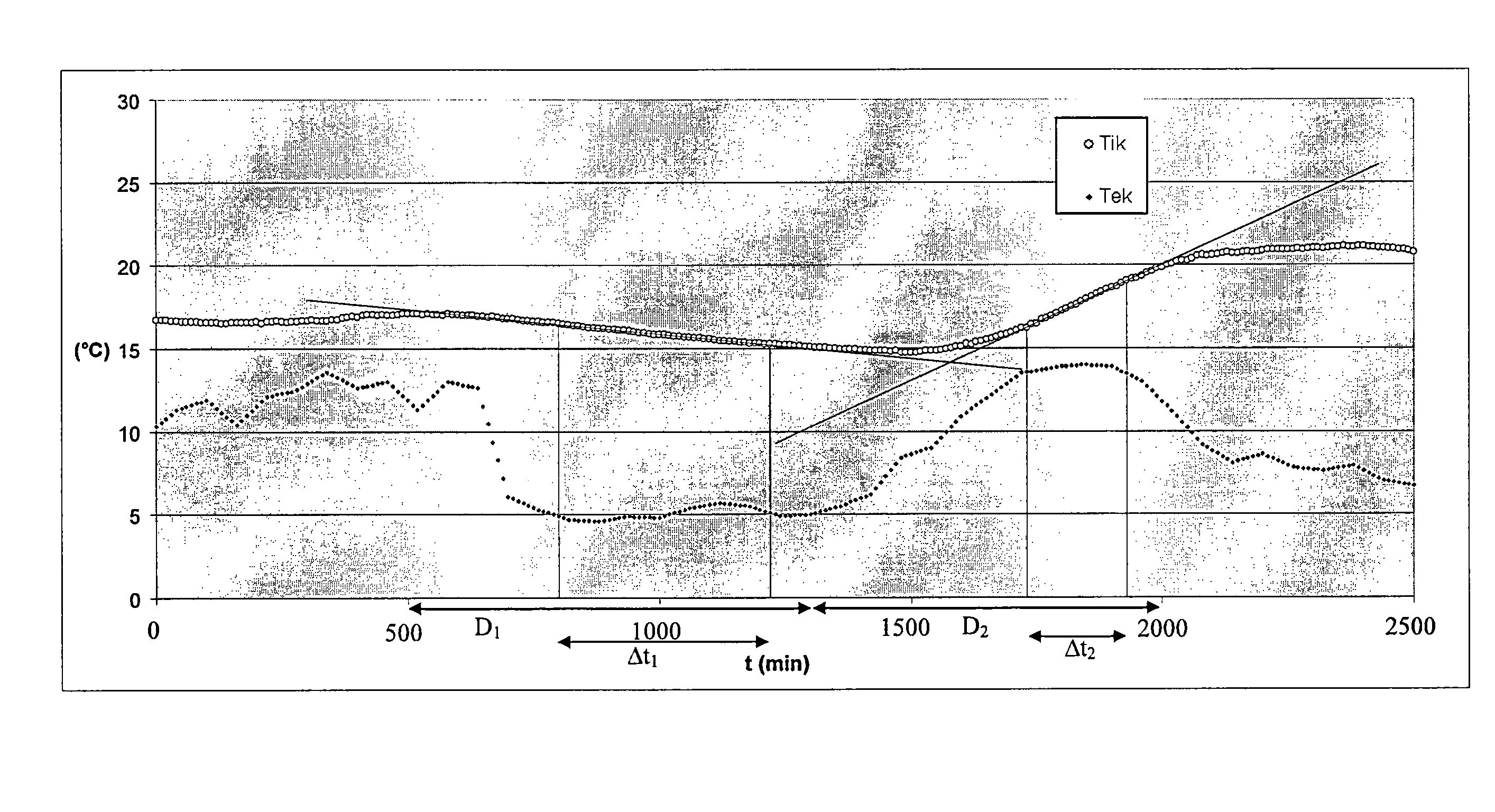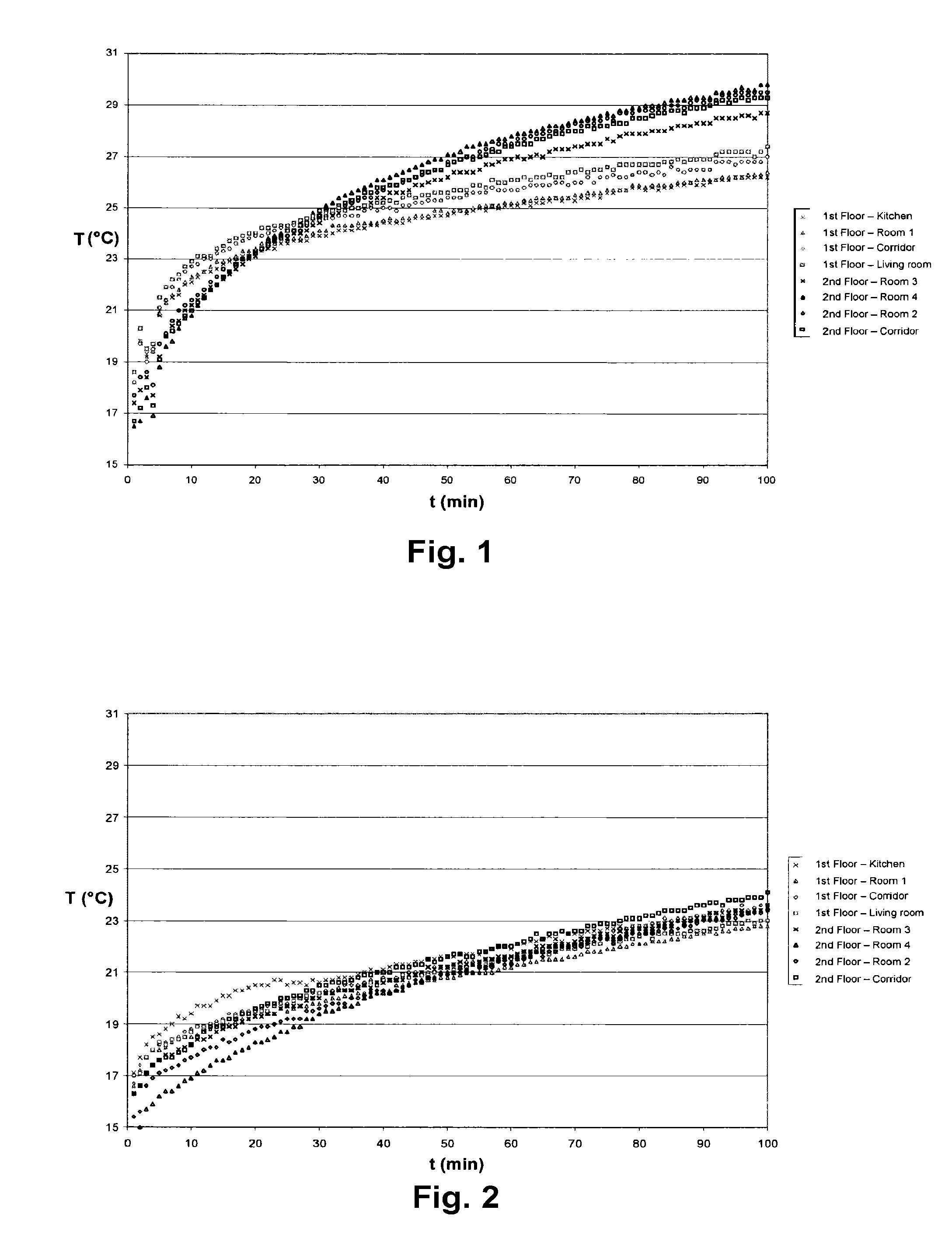Method and device for determining the heat loss coefficient of a premises
- Summary
- Abstract
- Description
- Claims
- Application Information
AI Technical Summary
Benefits of technology
Problems solved by technology
Method used
Image
Examples
example 1
[0117]With reference to FIG. 3, the method according to the invention is implemented for the determination of the heat loss coefficient K of an individual house 1 of recent construction, equipped with a heat pump 2. The heat pump 2 feeds a floor-based heating system 3 allowing homogeneous heating of the house. In particular, the floor-based heating system 3 ensures heating of the house 1 such that the temperature of the walls inside the house is substantially equal to the temperature of the ambient air inside the house. The heat loss coefficient K of the house 1 may be sought within the framework of a diagnosis of the energy performance of the house, for example to verify that the house 1 satisfies certain quality labels in terms of thermal insulation, such as the BBC label or the Passivhaus label.
[0118]The heating power provided by the heat pump 2 for the heating of the house is readily determinable, in particular on the basis of the COP of the heat pump as explained previously. Th...
example 2
[0144]With reference to FIGS. 7 and 8, the method according to the invention is implemented for the determination of the heat loss coefficient K of a bungalow 10 which has an interior volume Vi of 5.8 m×2.1 m×2.6 m and which is fitted with two triple-glazed windows. The envelope of the bungalow 10 consists of insulating sandwich panels assembled via a metallic structure. An additional insulation has been added to the envelope, in the form of a 40 mm thickness of glass wool and of a plasterboard as interior lining of the envelope. The permeability to air, measured by tracer gas, is 0.43 vol / h. The method is implemented whilst the bungalow is unoccupied.
[0145]The heating of the bungalow 10 is ensured by electric convectors 20 having a measured actual power of 1880 W. The convectors make it possible to heat the air in the bungalow and, on account of the limited volume of the bungalow, the heating of the bungalow is homogeneous. The convectors 20 constitute a controlled power source tha...
example 3
[0172]In order to verify the validity of the assumptions upon which the method of the invention rests, virtual trials have been carried out with the TRNSYS software on a fictitious house having an inhabited part of 12.10 m×9.90 m×2.50 m and a total loss area S=350 m2. More precisely, two series of computations have been performed:[0173]a first series corresponding to steady conditions obtained with a non-realistic weather file, with no sun and by fixing the outside temperature at 10° C. and the power at 30 kW during the time required for the temperatures to stabilize (400 hours at the maximum);[0174]a second series corresponding to transient conditions obtained with a realistic weather file, namely 3 days in March for a climate matched to the town of Chambéry, by supplying power distributed homogeneously, either via the floor at the surface (not depth-wise), or via the air, of 30 kW from 7 pm to midnight, and of 3 kW during the following 36 hours, after regulation to 19° C. for a da...
PUM
 Login to View More
Login to View More Abstract
Description
Claims
Application Information
 Login to View More
Login to View More - R&D
- Intellectual Property
- Life Sciences
- Materials
- Tech Scout
- Unparalleled Data Quality
- Higher Quality Content
- 60% Fewer Hallucinations
Browse by: Latest US Patents, China's latest patents, Technical Efficacy Thesaurus, Application Domain, Technology Topic, Popular Technical Reports.
© 2025 PatSnap. All rights reserved.Legal|Privacy policy|Modern Slavery Act Transparency Statement|Sitemap|About US| Contact US: help@patsnap.com



